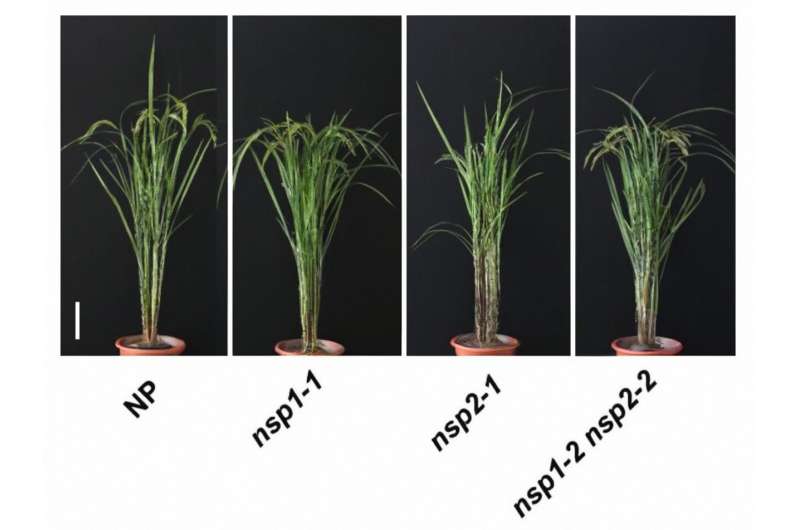This article has been reviewed according to Science X's editorial process and policies. Editors have highlighted the following attributes while ensuring the content's credibility:
fact-checked
peer-reviewed publication
trusted source
proofread
Scientists discover how low phosphorus regulates rice architecture and nutrient uptake

Researchers led by Dr. Wang Bing and Li Jiayang from the Institute of Genetics and Developmental Biology of the Chinese Academy of Sciences have shown that low phosphorus activates the biosynthesis and signaling of strigoalactones to regulate plant architecture and nitrogen and phosphate uptake in rice.
The researchers also developed transgenic plants with higher nutrient use efficiency, improved shoot and root architecture, and increased biomass and grain yield under low- and medium-phosphorous conditions. The study was published in Molecular Plant on Oct. 4.
Phosphorus is one of the macroelements required for crop growth and development. High crop yield depends on the heavy use of chemical fertilizers, such as phosphorus fertilizers, which increase crop yield but reduce the efficiency of phosphorus use. Phosphorus rock is a non-renewable resource, and the excessive production and application of phosphorus fertilizer have led to the waste of agricultural resources and environmental pollution, which is unfavorable for the sustainable development of agriculture.
Therefore, it is important to explore the mechanisms of the low-phosphorus plant responses to improve phosphorus use efficiency, reduce phosphorus fertilizer application, and achieve the sustainable development of agriculture.
Strigolactones are a class of plant hormones that regulate various biological processes and play an important role in the response to phosphorus deficiency. Low-phosphorus stress significantly induces strigolactone biosynthesis in rice, but the transcription factors regulating this process have not been identified. The mechanisms by which strigolactone regulates key plant architecture and the balance of nitrogen and phosphorus in rice under low-phosphorus conditions remain unclear.
This study found that in the low-phosphorus environment, the rice phosphorus signaling core regulator OsPHR2 directly activates the expression of NSP1, NSP2 and strigolactone synthesis genes; NSP1 and NSP2 also form a heterodimer that directly binds to and activates the transcription of strigolactone synthesis.
Strigolactone further activates its signaling pathway to inhibit tiller bud elongation and reduce lateral root density by promoting the expression of the negative tiller regulator OsTB1 and inhibiting CRL1 expression, respectively. Interestingly, they found that strigolactones inhibit nitrogen uptake and transport by regulating the expression of nitrogen transporter genes such as OsNRT2.1, OsNRT1.1B and OsNAR2.1 and promote phosphorus uptake by activating the expression of phosphorus transporter genes OsPTs.
These results illustrate a new mechanism underlying the balance of nitrogen and phosphorus in rice.
Furthermore, the researchers found that although overexpression of NSP1 and NSP2 with constitutive promoters resulted in reduced tiller number, panicle length and grain yield, overexpression of NSP1 and NSP2 with their own promoters performed appropriately elevated strigolactone biosynthesis and increased phosphorus absorption in a low-phosphorus environment. The NSP1p:NSP1 and NSP2p:NSP2 plants showed increased nitrogen uptake, increased tiller number, panicle length, biomass, and grain yield per plant under low- and medium-phosphorus conditions.
In conclusion, the researchers revealed the regulatory mechanisms of strigolactone biosynthesis and the role of strigolactone signaling in adaptation to low-phosphorus environments. This study provides genetic resources and effective strategies for improving rice architecture and nutrient use efficiency under low-phosphorus conditions, and lays a solid foundation for the molecular design and breeding of high-yielding and high-efficiency crops.
More information: Kun Yuan et al, Low phosphorus promotes NSP1–NSP2 heterodimerization to enhance strigolactone biosynthesis and regulate shoot and root architectures in rice, Molecular Plant (2023). DOI: 10.1016/j.molp.2023.09.022. www.cell.com/molecular-plant/f … 1674-2052(23)00313-1
Journal information: Molecular Plant
Provided by Chinese Academy of Sciences




















